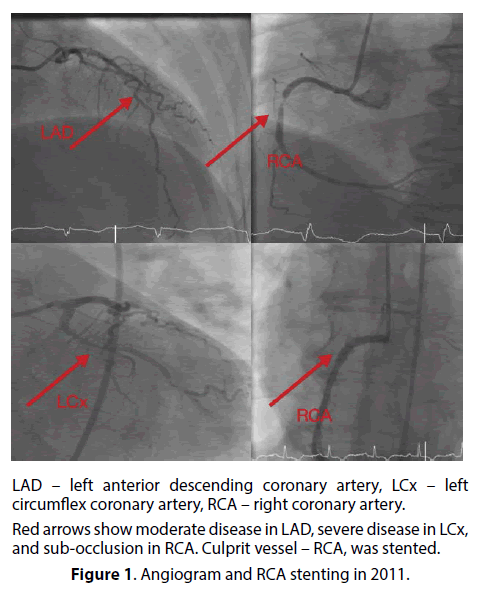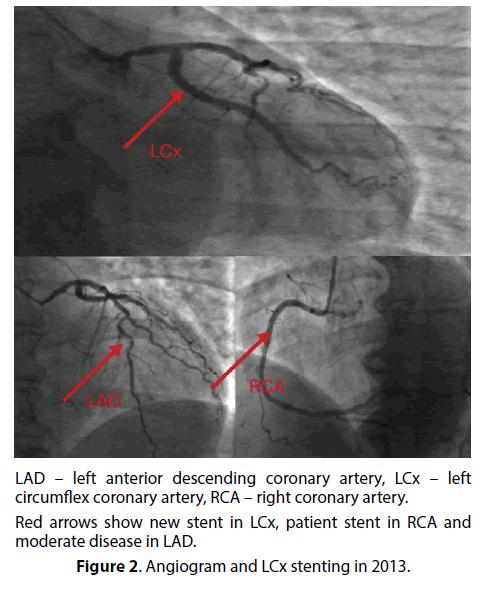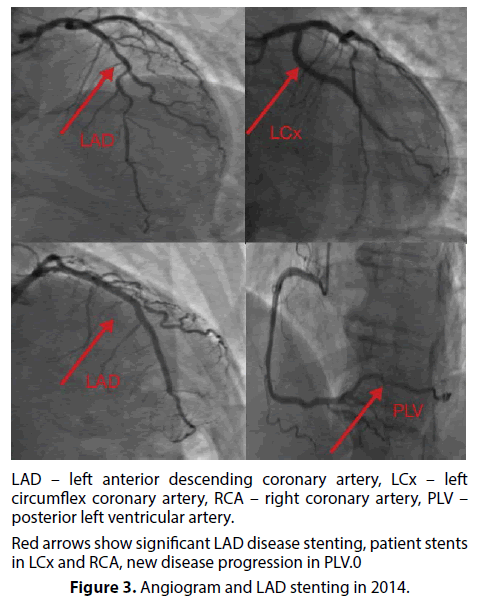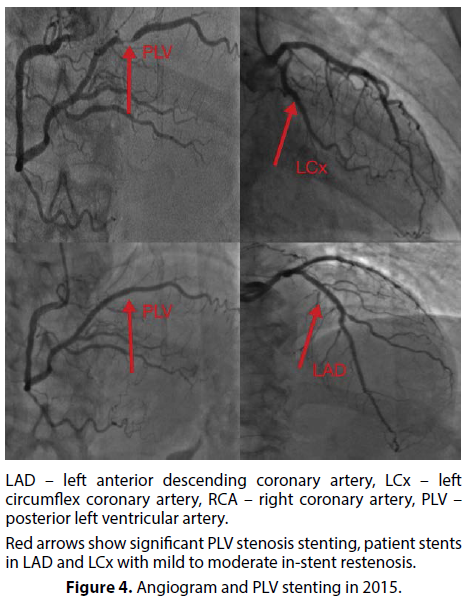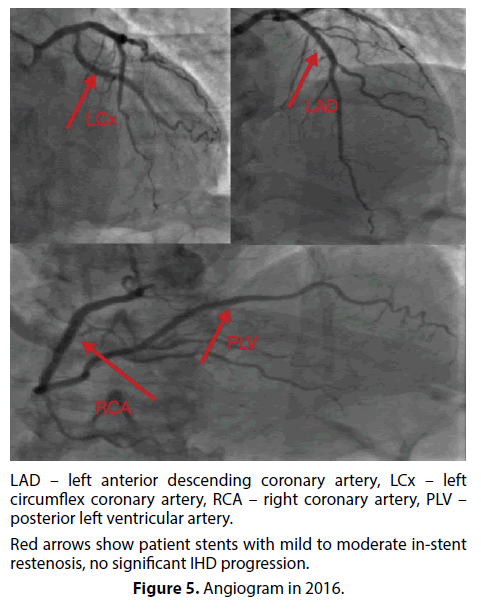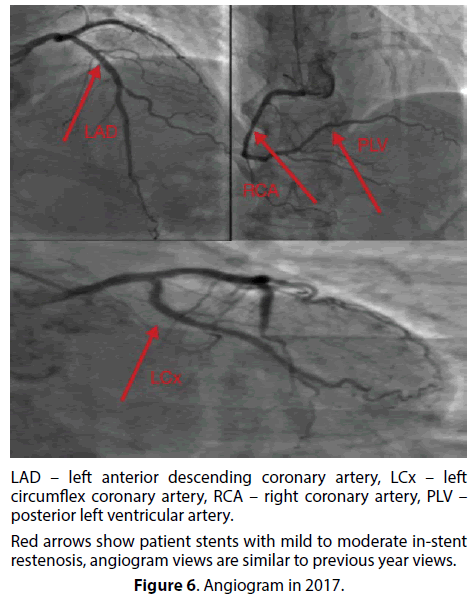Case Report - Interventional Cardiology (2018) Volume 10, Issue 2
PCSK9 Inhibitors-angiographically Proved Efficacy To Stop Aggressive Ischaemic Heart Disease Progression
- Corresponding Author:
- Zebrauskaite A
Department of Cardiology
University Hospital Limerick, Ireland
Tel: 91-9323361116
E-mail: Zebrauskaite.aiste@gmail.com
Submitted: March 21, 2018 Accepted: April 23, 2018 Published online: April 30, 2018
Abstract
It is well established that elevated level of cholesterol is the main factor for development and progression of cardiovascular disease (CVD). Low-density lipoprotein cholesterol (LDL-C) has been strongly associated with CVD. Lowering LDL-C reduces atherosclerotic disease risk and progression, irrespectively of how the reductions are achieved. The efficacy of statins is well known and proved by multiple trials. But the target LDL-C level cannot always be achieved by using maximally tolerated statin dose, overwise there are part of patients who have an intolerance for the statin. The new group of lipid-lowering drugs - PCSK9 inhibitors (PCSK9I) is monoclonal antibodies that bind to serum PCSK9 and delay LDL receptor degradation. Two PCSK9I are commercially available: evolocumab and alirocumab. Indications to use PCSK9I include LDL-C lowering on maximally tolerated statin therapy in patients with CAD or Familial Hypercholesterolemia. We present a case report of a 70-year-old lady with aggressively progressive ischaemic heart disease (IHD) and intolerance to the statin. Great clinical and angiographical improvement was achieved by prescribing PCSK9I.Introduction
It is well established that elevated level of cholesterol is the main factor for development and progression of cardiovascular disease (CVD). Low density lipoprotein cholesterol (LDL-C) has been strongly associated with CVD [1-5]. Lowering LDL-C reduces atherosclerotic disease risk and progression, irrespectively of how the reduction is achieved [1-2,6]. The efficacy of statins is well known and proved by multiple trials [7]. But the target LDL-C level cannot always be achieved by using maximal tolerated statin dose, overvise there are part of patients who have intolerance for statin. The new group of lipid lowering drugs – PCSK9 inhibitors (PCSK9I) are monoclonal antibodies that bind to serum PCSK9 and delay LDL receptor degradation [8]. Two PCSK9I are commercially available: evelocumab and alirocumab. Indications to use PCSK9I include LDL-C lowering on maximally tolerated statin therapy in patients with CAD or Familial Hypercholesterolemia [1-2,6].
Case Report
We present a case report of 70 year old lady with aggressively progressive ischaemic heart disease (IHD) and intolerance to statin. Great improvement was achieved by prescribing PCSK9I. Patient has a background history of high blood pressure, dyslipidaemia, intolerance to statin, positive IHD family history.
For this lady IHD presented as inferior ST elevation myocardial infarction at age 64. Angiogram revealed sub-occlusion of right coronary artery (RCA) and mild to moderate changes in left anterior descending (LAD) and left circumflex (LCx) arteries. RCA was stented with drug eluting stent (DES) dual antiplatelet therapy (DAPT) and statin was prescribed. Initial LDL-C was 6.0 mmol/l. After 3 months statin was stopped due to elevated liver enzymes. We started Ezetimib which was stopped in two-week time because of gastrointestinal tract irritation.
Patient had progression of angina symptoms; she got repeated angiograms and treatment with DES every year: LCx stenting in 2012, LAD stenting in 2013-2014, and posterior left ventricular (PLV) artery of RCA stenting in 2015. LDL-C was 6.0 mmol/l. PCSK9I Alirocumab injections every two weeks were prescribed. We got good response to PCSK9I. LDL-C decreased up to 3.0 mmol/l. Lowering LDL-C levels stopped IHD progression. We performed repeated angiograms in 2016 and 2017, there were no significant IHD progression seen. All examples of performed angiograms and stentings are shown in Figures 1-6. Angina symptoms stay stable. Patient has a great improvement in exercising capacity and in quality of life.
Figure 1: Angiogram and RCA stenting in 2011.
Figure 2: Angiogram and LCx stenting in 2013.
Figure 3: Angiogram and LAD stenting in 2014.
Figure 4: Angiogram and PLV stenting in 2015.
Figure 5: Angiogram in 2016.
Figure 6: Angiogram in 2017.
Discussion
Efficacy and safety of two PCSK9I agents’ evelocumab and alirocumab when prescribed on the top of statin was proved by two large randomized trials. They were shown to reduce LDL-C levels by approximately 60% that results in decreasing rates of coronary events and stabilisation of IHD [9-10]. Coronary events reduction was related to decrease LDL-C levels. It is proved that statins have not only LDL-C lowering but also a cardiovascular pleiotropic effect [11-12]. There are no evidences that PCSK9I alone can have the similar effect.
Guidelines recommend to prescribe PCSK9I for patients who has insufficient control of LDL-C levels with maximal tolerated statin dose, for patients who have statin intolerance and for patients with familial hypercholesterolemia combined with statin [1-2,6]. However, there are no data about PCSK9 efficacy in reducing cardiovascular events rate if prescribed alone even for patient with intolerance to statin.
Our patient was treated with PCSK9I alone, and we observed good clinical and angiographic effect. We did not reach the target recommended LDL-C level<1.8mmol/l, but recommended LDL-C reduction up to 50% was achieved [1-2,6]. LDL-C reduction by 50% was enough to stop IHD progression, keep angina symptoms stabile and improve patient’s exercise capacity.
References
- Catapano AL, Graham I, De Backer G, et al. 2016 ESC/EAS Guidelines for the Management of Dyslipidaemias. Eur Heart J. (39):2999-3058 (2016).
- Jellinger PS, Handelsman Y, Rosenblit PD, et al. American Association of Clinical Endocrinologists and American College of Endocrinology guidelines for management of dyslipidemia and prevention of cardiovascular disease. Endocr Pract. 23(Suppl 2):1-87 (2017).
- Stamler J, Wentworth D, Neaton JD. Is the relationship between serum cholesterol and risk of premature death from coronary heart disease continuous and graded? Findings in 356,222 primary screenees of the Multiple Risk Factor Intervention Trial (MRFIT), JAMA. 256: pp. 2,823-2,828 (1986).
- Verschuren WM, Jacobs DR, Bloemberg BP, et al. Serum total cholesterol and long-term coronary heart disease mortality in different cultures: twenty-five-year follow-up of the Seven Countries Study. JAMA. 274: pp. 131-136 (1995).
- Castelli WP, Anderson K, Wilson PW, et al. Lipids and risk of coronary heart disease: the Framingham Study. Ann. Epidemiol. 2: pp. 23-28 (1992).
- Lloyd-Jones DM, Morris PB, Ballantyne CM, et al. 2016 ACC Expert Consensus Decision Pathway on the Role of Non-Statin Therapies for LDL-Cholesterol Lowering in the Management of Atherosclerotic Cardiovascular Disease Risk: A Report of the American College of Cardiology Task Force on Clinical Expert Consensus Documents. J Am Coll Cardiol. 68(1):92-125 (2016).
- Law MR, Wald NJ, Rudnicka AR. Quantifying effect of statins on low density lipoprotein cholesterol, ischaemic heart disease, and stroke: systematic review and meta-analysis. Vasc Med. 8(4):289-90 (2003).
- Page MM, Watts GF. PCSK9 inhibitors – mechanisms of action. Aust Prescr. 39(5): 164–167 (2016).
- Robinson JG, Farnier M, Krempf M, et al. Efficacy and safety of alirocumab in reducing lipids and cardiovascular events. N Engl J Med. 372:1489–1499 (2015).
- Sabatine MS, Giugliano RP, Keech AC, Honarpour N, Wiviott SD, Murphy SA et al. Evolocumab and clinical outcomes in patients with cardiovascular disease. N Engl J Med 2017; DOI:10.1056/NEJMoa1615664.
- Liao JK, Laufs U. Pleiotropic effects of statins. Annu Rev Pharmacol Toxicol. 45:89–118 (2005).
- Oesterle A, Laufs U, Liao JK. Pleiotropic Effects of Statins on the Cardiovascular System. Circ Res. 120(1):229-243 (2017).
